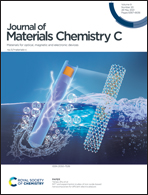Towards shape-oriented Bi-doped CoCr2O4 nanoparticles from theoretical and experimental perspectives: structural, morphological, optical, electrical and magnetic properties†‡
Abstract
In the present work, Co(1−x)BixCr2O4 (where x = 0.00, 0.05, and 0.10) nanoparticles were investigated in detail by combining theoretical and experimental efforts. The Co(1−x)BixCr2O4 (where x = 0.00, 0.05, and 0.10) nanoparticles were synthesized via a solution combustion method and studied through structural, microstructural, electrical, and magnetic analysis complemented by DFT calculations. The structural analysis confirmed a single-phase spinel cubic structure with singular structural distortions associated with Bi-doping and the generation of metal vacancies. The nanoparticles mainly enclosed the (100), (110), and (311) surfaces of the cubic spinel chromite structure, resulting in under-coordinated Co, Cr and Bi centers along their exposed surfaces. The dielectric parameters were explained using Koop's phenomenological theory, Maxwell-Wanger theory, and thermal energy of the vibrations, highlighting the role of Bi-doping in controlling the ferroic orders for the Co(1−x)BixCr2O4 nanoparticles. Moreover, the magnetic analysis indicated a paramagnetic to long-range collinear ferrimagnetism transition at the Curie temperature and non-collinear ferrimagnetism at the spiral transition temperature. These transitions are associated with the exchange coupling constants, as evaluated by DFT calculations before and after Bi-doping. Indeed, the effect of Bi-doping on the magnetic properties was determined to be a reduction in superficial magnetism, resulting in a diminished magnetization value for the doped samples, which is attributed to the major exposure of the (110) and (311) surfaces. Furthermore, the investigation of the morphological modulation of Co(1−x)BixCr2O4 nanoparticles through this innovative and unified procedure can guide other experimental studies in the rational design of superior multiferroic nanoparticles.



 Please wait while we load your content...
Please wait while we load your content...